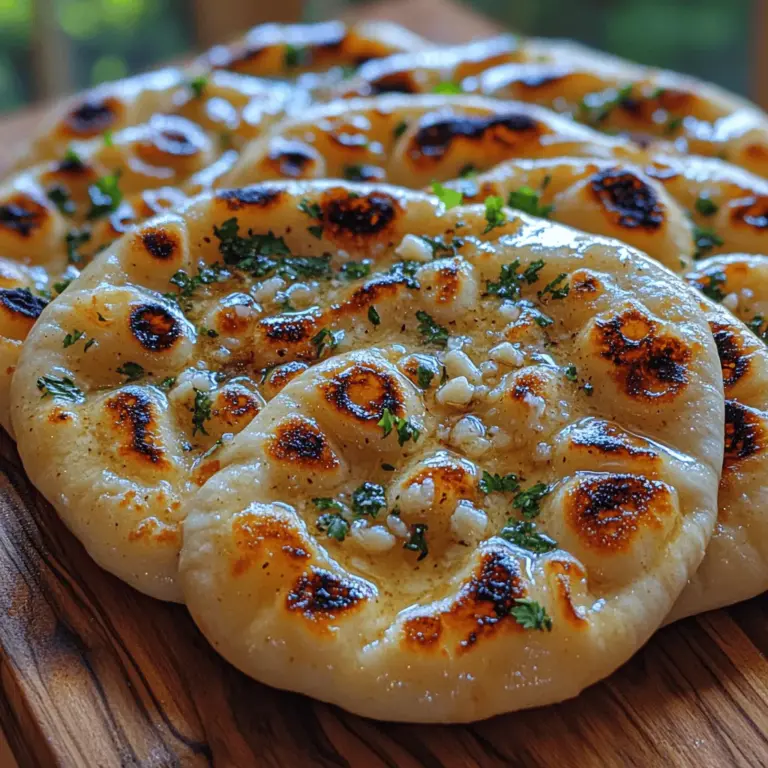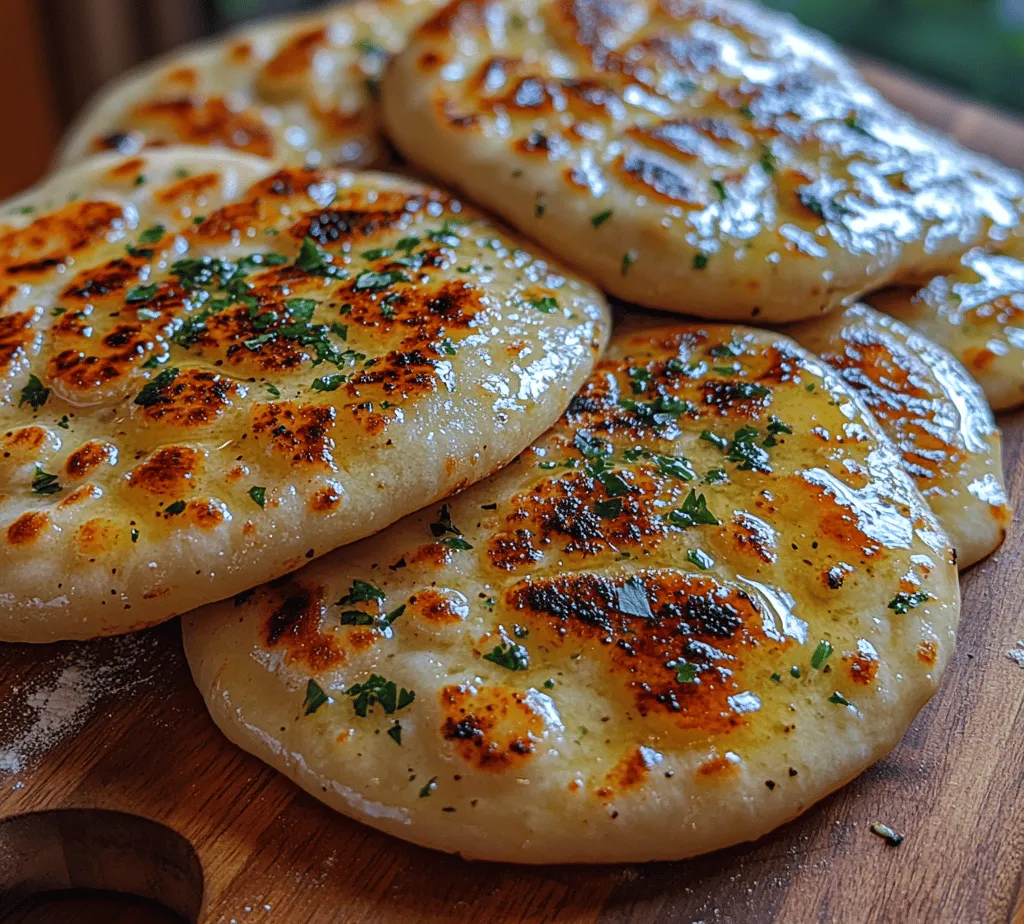Introduction
Naan is not just any flatbread; it’s a beloved staple in Indian cuisine, known for its soft, pillowy texture and versatility in complementing various dishes. This traditional Indian bread is often served alongside aromatic curries, rich stews, or simply enjoyed on its own with a smear of butter. Among the many variations of naan, garlic naan stands out as a crowd favorite, infusing delightful garlic flavor into each bite. Its soft and buttery nature, combined with the irresistible aroma of roasted garlic, makes it a must-try for any bread lover.
Garlic naan holds a special place in Indian dining culture, often found gracing the tables of families and restaurants alike. The combination of warm, freshly baked naan with a hint of garlic creates a comforting experience that transports you straight to the heart of India. This recipe for homemade garlic naan promises to deliver that same delightful experience right in your kitchen. With its appealing texture and flavor, this naan recipe is perfect for impressing guests or simply treating yourself to a delicious meal.
In this guide, we will delve into the art of making garlic naan from scratch. We will cover the history and significance of naan, break down the ingredients needed, and provide you with a comprehensive step-by-step guide to creating this delectable bread.
Understanding Naan
Naan is defined as a type of leavened flatbread, traditionally cooked in a tandoor, or clay oven. Its origins can be traced back to South Asia, where it has been a staple for centuries. The word “naan” itself is derived from the Persian word for bread, highlighting the cultural influences that have shaped its evolution throughout history. Naan is typically made from all-purpose flour, which gives it its characteristic softness and chewiness.
In Indian and South Asian dining, naan is more than just a side dish; it serves as an essential component of the meal, often used to scoop up rich curries and gravies. Naan comes in various forms, each with its unique flavor and texture. Some popular variations include plain naan, stuffed naan, and the famous garlic naan. Each type of naan offers a distinct culinary experience, making it a versatile choice for any meal.
Garlic naan, in particular, is prepared by incorporating minced garlic into the dough or brushing it with garlic-infused butter before serving. This addition elevates the naan, giving it a robust flavor that pairs beautifully with a wide range of dishes. Whether you’re enjoying a creamy butter chicken or a spicy vegetable curry, garlic naan is the perfect accompaniment.
Ingredients Breakdown
To make the perfect homemade garlic naan, it’s essential to understand the role each ingredient plays in achieving that soft, buttery texture and aromatic flavor. Let’s take a closer look at the key ingredients you’ll need for this recipe.
All-Purpose Flour
All-purpose flour is the backbone of naan, providing the structure and texture needed for this bread. It contains a moderate amount of protein, which contributes to gluten development. When kneading, the gluten forms a network that gives naan its chewy yet tender consistency. For best results, use high-quality all-purpose flour to achieve the desired softness.
Sugar
Sugar may seem like an unusual ingredient in bread, but it plays a crucial role in enhancing flavor. It adds a hint of sweetness that balances the savory elements of the naan. Additionally, sugar helps in browning the bread during cooking, giving it an appealing golden crust.
Salt
Salt is a fundamental ingredient that enhances the overall taste of the naan. It not only flavors the bread but also strengthens the gluten structure, contributing to the naan’s chewy texture. A pinch of salt is all you need to elevate the flavors.
Baking Powder and Baking Soda
These two leavening agents are essential for achieving a soft and fluffy naan. Baking powder provides an initial lift, while baking soda helps to create a tender crumb. Together, they work to ensure that your naan rises adequately, resulting in a light and airy bread.
Yogurt
Yogurt is a key ingredient in many naan recipes, and for good reason. It adds moisture to the dough, resulting in a softer texture. The acidity of yogurt also reacts with the baking soda, helping to create a perfect rise. Moreover, it imparts a subtle tanginess that enhances the flavor profile of the naan.
Warm Water
Warm water is necessary to activate the yeast and bind all the ingredients together. The warmth helps to awaken the yeast, which is crucial for leavening the dough. It’s important to use water that is warm but not hot, as excessive heat can kill the yeast.
Butter
Butter brings richness and flavor to the naan. Brushing the naan with melted butter after cooking adds a luxurious touch, enhancing the overall taste and creating a glossy finish. You can also infuse the butter with garlic for an extra punch of flavor.
Garlic
The star ingredient of garlic naan, fresh garlic not only adds a distinct and aromatic flavor but also provides health benefits. When mixed into the dough or brushed on top, garlic transforms the naan into a mouthwatering treat that elevates any meal.
Fresh Cilantro (Optional)
While not mandatory, fresh cilantro adds a bright, herbal note to the naan. It can be chopped and mixed into the dough or sprinkled on top for garnish. This optional ingredient enhances the visual appeal and adds freshness to the overall flavor profile.
Step-by-Step Guide to Making Garlic Naan
Preparing the Dough
The first step in making garlic naan is preparing the dough. Start by gathering all your ingredients and measuring them accurately for the best results. In a large mixing bowl, combine the all-purpose flour, sugar, salt, baking powder, and baking soda. Mix the dry ingredients together until they are evenly distributed.
Next, create a well in the center of the dry mixture. Add the yogurt and warm water into the well, followed by the minced garlic. Using your hands or a wooden spoon, gradually mix the wet ingredients into the dry ingredients until a rough dough begins to form.
Mixing Dry Ingredients and Combining with Wet Ingredients
It’s essential to ensure that the dry ingredients are thoroughly mixed before adding the wet components. This step helps create a uniform dough. Incorporate the yogurt and warm water slowly, making sure to mix well to avoid any lumps. The goal is to achieve a shaggy dough that holds together but is not overly sticky.
Importance of Achieving the Right Dough Consistency
Achieving the right dough consistency is crucial for the texture of the naan. The dough should be soft and pliable but not too sticky. If the dough feels too wet, you can add a little more flour, a tablespoon at a time, until you reach the desired consistency. Conversely, if it’s too dry, add a splash of warm water until it becomes manageable.
Kneading the Dough
Once your dough has come together, it’s time to knead. Turn the dough out onto a lightly floured surface and begin kneading it for about 5 to 10 minutes. To knead effectively, fold the dough over itself and push it down with the heel of your hand. Rotate the dough a quarter turn and repeat the folding and pressing motion.
Visual Cues for Knowing When the Dough is Ready
The dough is ready when it becomes smooth and elastic. A good test for doneness is the “windowpane test”: take a small piece of dough and stretch it gently with your fingers. If it stretches thin enough to let light through without tearing, it’s ready. If it tears easily, continue kneading for a few more minutes.
Allowing the Dough to Rise
After kneading, shape the dough into a ball and place it in a lightly greased bowl. Cover the bowl with a damp cloth or plastic wrap to prevent it from drying out. Allow the dough to rise in a warm, draft-free area for about 1 to 2 hours, or until it has doubled in size. This resting period is crucial as it allows the gluten to relax and the yeast to work its magic, resulting in a light and airy naan.
—
Stay tuned for the next segment, where we will explore the cooking methods for your garlic naan and share tips for achieving perfect results every time!
Homemade Garlic Naan – Soft, Buttery & Delicious!
Importance of the First Rise and the Science Behind It
The first rise, also known as fermentation, is a crucial step in the preparation of homemade garlic naan. This process allows yeast to feed on sugars present in the dough, producing carbon dioxide gas, which helps the dough to expand and develop its characteristic soft texture. The fermentation process not only enhances the flavor of the naan but also aids in gluten development, resulting in a chewy, airy bread.
Understanding the science behind this rise can elevate your naan-making skills. As the yeast ferments, it creates a complex array of flavors and textures. The longer the dough rises, the more flavor it develops, which is why allowing for a longer fermentation—ideally in a warm, draft-free area—can result in a tastier naan.
Tips for Creating the Ideal Environment for Rising
To ensure your dough rises perfectly, creating the right environment is essential. Here are some helpful tips:
1. Temperature: Yeast thrives in warm temperatures. Aim for a space between 75°F and 85°F (24°C to 29°C). If your kitchen is cool, consider placing the dough in a preheated oven (turned off) or near a warm spot, such as on top of your refrigerator.
2. Covering the Dough: Prevent the dough from drying out by covering it with a damp kitchen towel or plastic wrap. This will keep the moisture levels up and ensure an even rise.
3. Humidity: If your environment is too dry, consider placing a small bowl of water in the oven with the dough to create a humid atmosphere.
4. Time: Allowing the dough to rise for at least one hour is crucial, but if time permits, letting it rise longer can yield even better results.
Preparing Garlic Butter
The garlic butter is what makes this naan truly special. It adds a rich, aromatic flavor that complements the soft, chewy texture of the bread.
Steps to Make the Garlic Butter Mixture
1. Ingredients: For the garlic butter, you will need:
– 4 tablespoons unsalted butter, melted
– 4 cloves garlic, finely minced
– Fresh parsley or cilantro, finely chopped (optional, for garnish)
– A pinch of salt
2. Mixing: In a small bowl, combine the melted butter with minced garlic and a pinch of salt. Mix well to ensure the garlic is evenly distributed in the butter.
3. Timing with Garlic: Timing is crucial when it comes to garlic. If you let it sit in the melted butter for too long before using it, it can develop a bitter taste. Prepare the garlic butter while the naan is cooking to keep the garlic fresh and flavorful.
Shaping the Naan
Once your dough has risen beautifully, it’s time to shape the naan. This step can be fun and creative, allowing you to customize the shapes and sizes of your bread.
Techniques for Dividing and Shaping Dough into Naan
1. Portioning: Begin by gently deflating the dough and dividing it into equal portions—typically about 8 pieces for standard naan size. Use a bench scraper or a sharp knife for clean cuts.
2. Shaping: Roll each piece into a ball, then flatten it slightly with your palm.
3. Resting the Dough: Let the shaped dough balls rest for about 10-15 minutes. This resting period is essential as it relaxes the gluten, making it easier to roll out the naan without it springing back.
Rolling Out Naan
When it comes to rolling out naan, achieving the right thickness and shape is key to a successful cook.
Tips for Achieving the Desired Thickness and Shape
1. Flouring: Lightly flour your work surface and rolling pin to prevent sticking.
2. Thickness: Aim for about ¼ inch thickness. Too thin will result in a crispier texture, while too thick will make it doughy.
3. Shape Variations: While traditional naan is teardrop-shaped, feel free to experiment with round or square shapes as well. The most important aspect is achieving a consistent thickness for even cooking.
Cooking the Naan
Cooking naan can be done in a few different ways, but using a cast-iron skillet or frying pan is the most accessible option for home cooks.
Explanation of Using a Cast-Iron Skillet or Frying Pan
1. Preheat: Heat your cast-iron skillet or frying pan over medium-high heat until it’s hot. You can test this by sprinkling a few drops of water onto the surface—if they sizzle and evaporate immediately, it’s ready.
2. Cooking Time: Place a rolled-out naan in the skillet and cook for about 1-2 minutes, or until bubbles start to form on the surface. Flip it over and cook for another 1-2 minutes, until golden brown and slightly charred.
3. Doneness: The naan is done when it has puffed up and develops a slightly charred crust. You can also press down gently with a spatula to encourage puffing.
Brushing with Garlic Butter
As soon as the naan comes off the skillet, brushing it with the garlic butter mixture enhances its flavor and adds a beautiful shine.
Importance of Brushing Immediately After Cooking
Brushing the naan right after cooking allows the butter to seep into the warm bread, creating a deliciously fragrant and flavorful crust.
Tips for Maximizing Flavor with Garlic Butter
1. Generosity: Don’t skimp on the garlic butter—generously brush it over the top of each naan while it’s still warm.
2. Herbs: If you choose to add parsley or cilantro, sprinkle it over the naan after brushing with garlic butter for added freshness and visual appeal.
Serving Suggestions
Garlic naan is incredibly versatile and pairs well with a variety of dishes. Here are some serving suggestions:
1. Best Dishes to Pair with Garlic Naan:
– Curries: Serve alongside rich, creamy curries like butter chicken or palak paneer.
– Stews: It complements hearty stews, offering a perfect vehicle for scooping up flavors.
2. Creative Ways to Enjoy Naan as a Snack:
– Wraps: Use naan as a wrap for grilled meats or roasted vegetables.
– Dips: Serve with hummus, tzatziki, or a spicy chutney for a quick snack.
3. Ideas for Using Leftover Naan:
– Pizzas: Top leftover naan with sauce, cheese, and your favorite toppings for a quick pizza.
– Croutons: Cut into pieces, season with spices, and bake for homemade naan croutons to add to salads.
Nutritional Information
Homemade garlic naan can be a delightful addition to your meals, offering certain nutritional benefits:
1. Nutritional Benefits:
– Naan provides carbohydrates for energy, while the garlic adds antioxidants and potential health benefits such as improved heart health.
– Using whole wheat flour can increase fiber content, making it a heartier option.
2. Caloric Breakdown and Health Considerations:
– A single piece of garlic naan typically contains around 200-250 calories, depending on the size and ingredients used. Consider portion sizes, especially if serving alongside calorie-dense dishes.
Conclusion
Making homemade garlic naan is a rewarding culinary experience that fills your kitchen with delightful aromas. The process—from the initial dough rise to the final brushing of garlic butter—offers an opportunity to create something truly special.
As you explore the versatility of garlic naan, consider how it can enhance various meals, whether as a side to your favorite curry or transformed into a delicious wrap. Baking your naan at home not only ensures freshness but also allows you to customize flavors to your liking. Embrace this culinary adventure, and savor the satisfaction of enjoying homemade garlic naan with family and friends.



